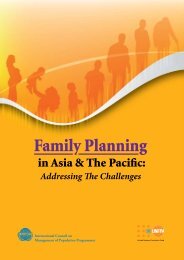national reproductive health strategy - Ministry of Public Health ...
national reproductive health strategy - Ministry of Public Health ...
national reproductive health strategy - Ministry of Public Health ...
You also want an ePaper? Increase the reach of your titles
YUMPU automatically turns print PDFs into web optimized ePapers that Google loves.
National Reproductive <strong>Health</strong> Strategy (2012–2016)STRATEGIC COMPONENTSComponent 1: Maternal and Neonatal <strong>Health</strong>In its primary role as steward <strong>of</strong> <strong>reproductive</strong> <strong>health</strong> services, the RHD will improve the quality andcoverage <strong>of</strong> maternal and neonatal <strong>health</strong> (MNH) care, primarily through advocacy, collaborationwith other MoPH units and other stakeholders, and overseeing implementation <strong>of</strong> partners’projects. Principal strategic approaches include:Strategic Approach 1.1: Increase women’s access to and utilization <strong>of</strong> antenatal care,skilled care, emergency obstetric and neonatal care (EmONC) and postpartum care1.1.1. Strengthen community-based <strong>health</strong> care delivery using community <strong>health</strong> workersMany Afghan women never leave their community, from the pre-conception period throughthe postpartum period. Because <strong>of</strong> this, beginning in 2011, the MoPH and implementingpartners will place a major emphasis on strengthening community-based MNH servicesusing community <strong>health</strong> workers (CHWs) in conjunction with family <strong>health</strong> action groups(FHAGs). Specifically: CHW job descriptions will be revised based on RH service requirements.Quality will be included as an integral part <strong>of</strong> CHW activities, in consultation with theImproving Quality in <strong>Health</strong> Care (IQHC) and Community-Based <strong>Health</strong> Care (CBHC)units.In-service and refresher training <strong>of</strong> <strong>reproductive</strong> <strong>health</strong> issues will be integrated,strengthened, and coordinated with CBHC in the following areas:Promoting <strong>health</strong>y behavioursProviding preventive careIdentifying problems and danger signsFacilitating and encouraging timely referralsEncouraging appropriate early care-seekingReferring to <strong>health</strong> facilities for other MNH servicesStrengthening linkages between CHWs and other community-based <strong>health</strong>participants such as community <strong>health</strong> supervisors (CHSs), <strong>health</strong> shuras,and community midwives (CMWs)As a result <strong>of</strong> the expansion <strong>of</strong> their role, CHWs, working with FHAGs, CHSs, <strong>health</strong> shuras,and CMWs, will be able to map pregnancies; provide <strong>health</strong> messages; provide vitamin A,iron folate, and anti-malarials; prepare and make available home delivery kits; ensurecleanliness and enhance mother education for proper birth planning; educate mothers onclean delivery principles; make postpartum visits to mothers and newborns according toschedule; promote early and exclusive breastfeeding; and refer patients to the <strong>health</strong> facilityas needed. While CHWs are not SBAs and do not conduct deliveries, they can be present atdeliveries to ensure cleanliness, keep the baby warm, promote early and exclusive breastfeeding, and so on.Page 9














